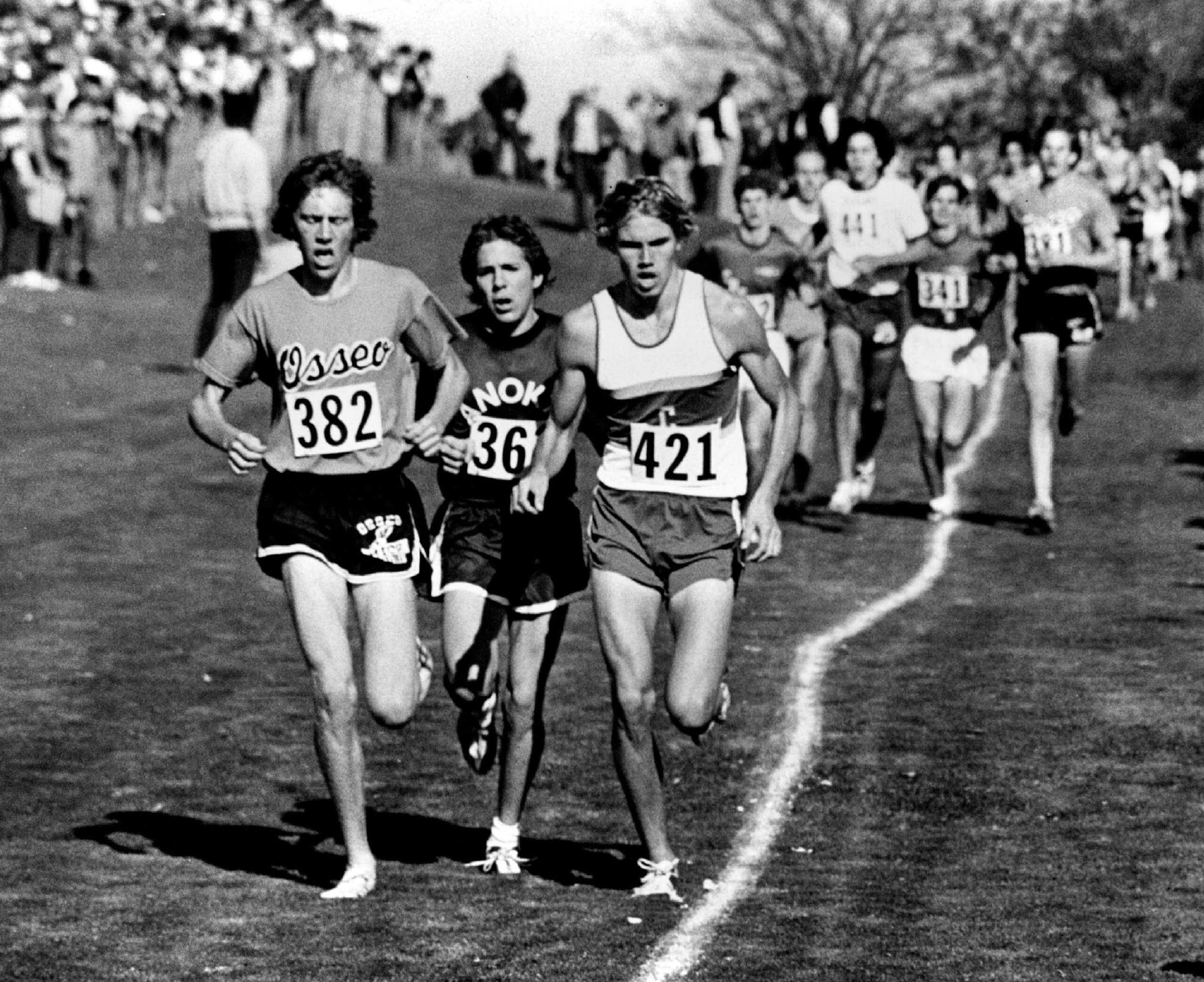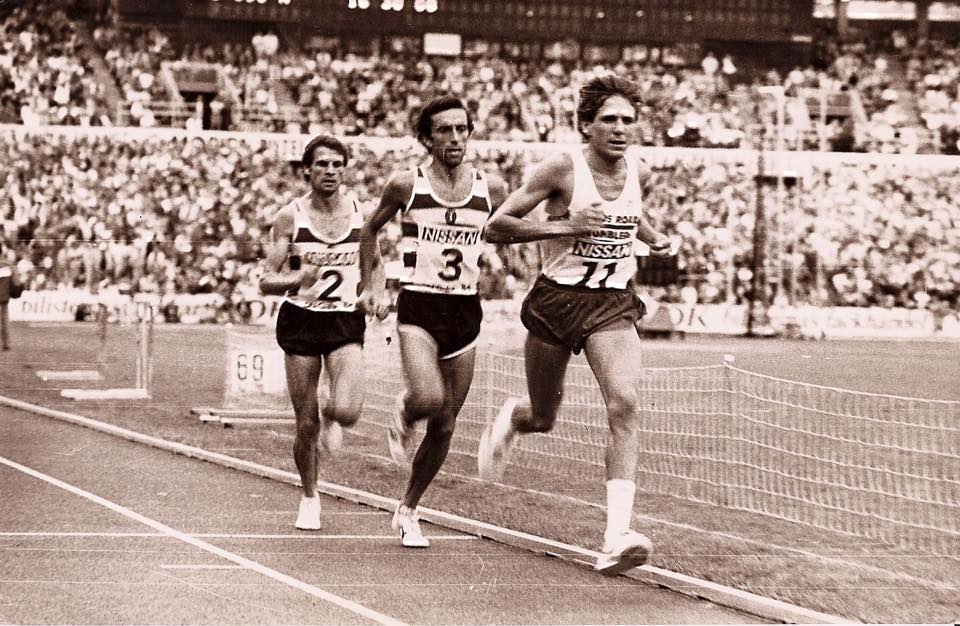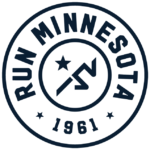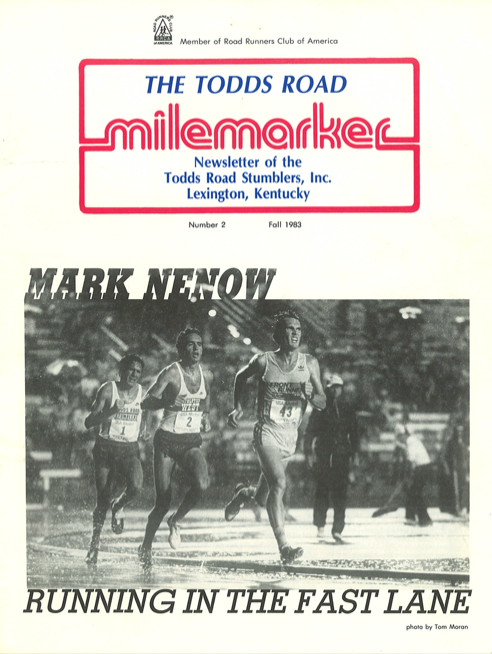
Mark Nenow
Words by: Sarah Barker
Even had the internet existed in the 1980s, Mark Nenow would have had a low profile. He rarely talked about himself, and trained alone using methods that worked for him, regardless of the wisdom of the day. Nenow is not even well known in his home state of Minnesota, though he broke 28 minutes for 10,000 meters ten times between 1982 and 1989, held the American record for 10,000 meters of 27:20 for 15 years, and, in the 1980s, world best for 10K on the road, 27:23. He was the top ranked U.S. 10K runner three times in the late 1980s, and was never ranked lower than fifth between 1981 and 1989. All of this, in shoes that barely provided coverage much less any sort of energy return. He was almost entirely self coached.
This Article Is Sponsored By
Run Minnesota, the oldest and largest running organization in the state, with a proud history of supporting running since 1961.
Anoka High School
Nenow’s early experiences at Anoka High School started him on the path to being one of the greatest distance runners in U.S. history.
Being slight of frame but strong, Nenow wrestled his freshman and sophomore years, and intended to keep up with it his junior year, but the four guys working with him at the Burger King talked him into joining cross country skiing instead. “I just wanted to hang out. I wasn’t that good at it,” he said. Nonetheless, he was one of the top skiers on the team that winter, 1973-1974, earning a varsity letter, something he said was “a motivator.”
School started his senior year the Tuesday after Labor Day. Nenow was surprised to receive a note in math class from the cross country coach, Bruce Johnson, that read, You’d better be at practice this afternoon. So, he went to practice. The first week consisted of 100 miles in five days. “Twenty miles a day, and we did it,” Nenow recalled. Other character building training sessions included 20 to 30 times up sandy hills, fartlek runs, trail runs near the high school, four to five mile repeats. Ten days into the season, Anoka had their first meet. Nenow was their top runner. With two months of running under his belt, he won the state cross country title in 15:10 for 4800 meters.
By the time track came around in the spring of his senior year, he was running 70-90 miles a week, with a long run of 12 miles. His mile repeats were all under 5:00 “and they didn’t feel that hard.” Getting beat by Blaine in the conference meet was a bit of a wake up call, but the team rallied, dusted off some vintage Anoka uniforms for inspiration and went one (Nenow), two, three, dominating the meet.
“The day before the state meet, the Star Tribune had the top ten (prospects to win), and I wasn’t on the list,” Nenow said. “I was tactically oblivious, never interested in who was ranked number one or who the other ranked people were.”
In what was to be his trademark style, Nenow went out at the front and ran his own race. “All of a sudden, there were three of us, then two, and somehow I won.”
“In retrospect, some of those attributes that made me strong in a competitive sense (not paying attention to others in the race) were my weakness, like in the Olympic Trials, when you do need to have a strategy.”

Kentucky
The first time running in college ever entered Nenow’s mind was after the state track meet. Prior to that his plan had been to attend the Air Force Academy. His PRs of 4:22 at the mile and 9:17 for two miles—which he remembered as an “easy race”—were good but not great, and the fact that he’d only been running for one year seemed to put coaches off. He did get recruitment letters and calls, but the only D1 school that offered him a scholarship was the University of Kentucky.
“The Kentucky coach was from Elk River. We met at an Embers, and a month later he gave me a scholarship,” Nenow recalled.
He was active over the summer but didn’t do much running. “I was never a very good summer runner. I could get in shape fast, from no running to running a lot.”
That ability came in handy, as he jumped right into 100 mile weeks at Kentucky. On a team of very talented runners every workout was a competition, and consequently, injuries were endemic. High mileage was the norm in the 1970s, so Kentucky was not unusual in that regard. Unfortunately for Nenow, who might have benefited from stable coaching as a neophyte, the coaching and administrative staff was in disarray. The coach who’d recruited him was fired his sophomore year, and the new coach, Don Weber, brought in almost an entirely new team.
Weber instituted regimented 6 a.m. workouts and insisted that team members live in the dorms on campus. This did not sit well with the individualistic Nenow.
“I was an awful racer. For two years in a row, I was almost last at NCAA Cross Country Nationals. There were maybe 10 guys behind me,” he said.
Partly due to unsuitable coaching, and partly to his lack of maturity as a runner, Nenow “didn’t do much” through his junior year. By senior year, he came to an agreement with Weber that he’d do his own training.
“I didn’t look in books or anything. I just had a sense that I had to run a lot. And I went back to night running.”
Being a night person anyway, this is how one of Nenow’s most abiding training quirks got started. Twelve to 14 miles in the afternoon at a quick pace—always sub-6:00, sometimes sub-5:00—on a hilly loop, and a second run at 11 p.m. of seven to eight miles, also fast. Same routes, six days a week with a 20 miler on Sunday. He estimates 95 percent of his training was done alone. It’s not that he thought he knew more than the coach or that others couldn’t do those workouts. He just wanted to do what he felt was right for him on that day.
By spring of his senior year his training was going well. He felt ready to run a fast 10,000 but needed the right race to help him achieve it. At the 1980 Penn Relays, there was a university 10,000 meters and an open race. Nenow, entered in the university race, wanted to run 28:45 but knew he had to be in the open race to accomplish it. “I had to find a way to get in that open section.” He unobtrusively stayed in the pen when the university runners were ushered onto the track, lining up instead in the open race. He ran 28:30.
Capping off his senior, he placed seventh in the NCAA 10,000 meter Championship, and qualified for the Olympic Trials. “That validated in my head that I didn’t need a coach and didn’t want input,” he said.
World Best at Crescent City Classic
Nenow finished 11th in the Olympic Trials 10,000 meter final, not, he said, dampened by the knowledge that the U.S. would boycott the 1980 Olympics, but rather indicative of a career long problem peaking for a particular race. “The way I trained never allowed me to pick a day and do it.”
He continued living in Lexington, enrolled in graduate school and received a stipend from Nike that allowed him to hit the track circuit in Europe for the first time in the summer of 1981. Though he’d sworn off coaching, he did respect Western Kentucky runner Nick Rose. “Nick gave me a 12 week program that was really simple, and I followed it to a tee.”
That program was much like he’d been doing—13 runs a week with a long run of 15 miles (Nenow hated long runs), hills in the first workout on Monday, track on Wednesday afternoon, rotating eight x 800, six x 1200 and four x mile with short rest, with the usual seven to eight miles at 11 p.m. Blasphemy to today’s runners, he didn’t time or measure anything, just stuck with the same hilly loops in Lexington he’d done since he first moved there. Using this protocol, Nenow managed his first big breakthrough—27:36 at Mount Sac in 1982. Nick Rose’s response? “What? Say again. I’m not going to be able to coach you anymore.”
And he didn’t. Nenow went back to his own program—20 to 25 miles a day, 13 runs a week, all of it in the low five minute range. Running with a radio, he “went all out for a song, easy during the commercial, then all out again for the next song.”
He was serious about time off—didn’t run from Thanksgiving to New Year’s Day, which he rang in with a 15 mile run. By the end of January, he was back to 140 miles/week.
After that 27:36, he thought the American record—Alberto Salazar’s 27:25 set in 1982—was within his grasp, but “didn’t go telling everyone.” He spent nearly half the year living and training in Teddington, England with coach and manager Kim McDonald, and McDonald’s stable of Kenyan runners. While Salazar, Greg Meyer, Bill Rodgers and Minnesota’s own Garry Bjorklund were very visibly ripping up the roads here in the U.S., Nenow did much of his racing in Europe, and trained alone in Lexington—not a hot spot— when he was in the U.S. Others tried to get him to join one of the training groups popping up, specifically Athletics West in Eugene, but he felt an inexplicable pull to his Lexington stomping grounds. He did, though, join a local running group, the delightfully named Todds Road Stumblers. Adding to his under-the-radar status, the marathon was the marquis event; the 10K, and even less so, 10,000 meters on the track, Nenow’s specialty, didn’t garner the same attention.
In early 1984, he did a couple road races as training for the Olympic Trials. The race director from the Crescent City Classic wanted him there but said he had no appearance money. That is, until Joan Benoit canceled.
“I felt like a million bucks,” he said. ”It didn’t matter how fast the others ran, I was just gliding, and I ran away from them at four miles.” It was a world best, 27:23, but not a world record since the Crescent City course is not eligible.
It appeared his run up to the 1984 Olympic Trials was going very well, he was in supreme shape, almost a shoo-in to make the team. As per usual, he didn’t taper much. “I didn’t make any adjustments (for anyone else in the race). I thought I was one of the hardest working guys there.” He finished 11th. Frustratingly proving his fitness, after the Trials, he went to Europe and paced Fernando Mamede to a world record on the track (27:13).
“After ‘84 the American record was still hanging out there,” Nenow said. He spent half the year in Teddington with Kim McDonald, and half the year in Lexington. Huge mileage, 140 per week, sometimes more. He ran a stellar 27:48 on the roads in March of 1985, and another 27:40 on the track in Stockholm but couldn’t seem to break through. McDonald, who Nenow had grown to trust, saw that the American was, as they say, doing the same thing and hoping for a different result. McDonald thought it would just take a few tweaks, nothing major, for Nenow to get into record making shape.
McDonald introduced him to British coach Alan Storey, who had coached Sonia O’Sullivan and, more recently, Mo Farah. Of course, knowing Nenow’s resistance to highly controlled coaching, Storey was merely a suggestion. He gave Nenow some workouts that he could take or leave. He took them.
“They injected some speed work and tempo running, but they didn’t try to change me,” Nenow said. Some examples—8K time trials, eight x 1600 w/45 second rest, 16 x 800 w/30 second rest.

10,000 Meter American Record!
“I flew back to Kentucky and did seven weeks of hard, hard training aiming to set the record in Brussels in September. I honestly wasn’t sure I could do it—8K on the track in hot weather in 22:10. A 10K in 29:00 as part of a workout.”
1986 was to be the year for the American record. All his training and racing was built around it. Of course, all the usual hurdles were there—there were few really high quality 10,000 meters, stacked with fast folks, run in any given season; there weren’t many pacers available who were capable of pacing an American record; because of the interval needed between hard efforts, you only got maybe three chances in a season; you had to remain injury free; and all of these variables had to align with a day that you felt really really good. Luck played a distressingly outsize role, Nenow admitted.
The first go in June 1986 in Oslo resulted in a 27:28, an eight second improvement on his PR, scaring the American record. Then a fast 5,000 in Paris showed he was still in fantastic shape. But he worried that maybe the Oslo race had been his only chance that season, that he wouldn’t be able to come back.
“I flew back to Kentucky and did seven weeks of hard, hard training aiming to set the record in Brussels in September. I honestly wasn’t sure I could do it—8K on the track in hot weather in 22:10. A 10K in 29:00 as part of a workout.”
The race was set up perfectly with a field of fast runners and several pacers who would take them through 5,000 meters. Nenow had asked them for 13:45 at the half, but they came through a little slower than that. Seconds mattered. Lapped runners sometimes relinquished the track at the last minute, breaking his rhythm slightly, but for the most part he felt smooth and fast, in the zone, the same nearly effortless sense that many record setters describe. He floated to the American record—27:20.56—which stood for nearly 15 years, until it was broken in 2001 by Meb Keflezighi.
Even as he celebrated his record setting run, it did not go unnoticed that he lapped Henry Rono, who’d always been an inspiration to him. It was a vivid display of the fleeting nature of athletic success.
Being a high mileage runner, Nenow seemed made for the marathon, so he kept training until November and ran the 1988 NYC Marathon, where he finished eighth in 2:14. A month later he had surgery on his hamstring, which was unsuccessful and had to be repeated. “I started training for the 1989 NYC Marathon, but the hamstring problem came back, and I dropped out. And that was it,” he said. Though he was only 32, he felt he was on the far side of his competitive career.
He had a third hamstring surgery but continued to be plagued by injuries. Nenow still had moments of brilliance—a 13:20 5,000 in 1989 and later that summer, a 27:42 10,000. And he set his road 5K PR in 1994, 13:56 at Carlsbad, but the miles had taken their toll.
He found a career in the athletic footwear industry, first working for Asics, then Nike, Brooks and Columbia, recently retiring from the top job at Sorel.
Running in this country, particularly track running, is only associated with the Olympics. When people find out Nenow is a runner, which rarely comes up in conversation, they ask if he’s been in the Olympics. They’re always a bit disappointed when he says No, no I haven’t. Certainly, setting the American record and those years around it were high points—and here you can cue Frank Sinatra’s My Way—but looking back, Nenow cherishes most what he learned about himself in all those miles stretching from Anoka, Minnesota to Lexington, Kentucky to the bucolic footpaths of Teddington, England.
Special Thanks To
The Todds Road Stumblers, which granted us permission to use their newsletter and for their kind responses.
The University of Kentucky Athletics for the use of their photos.

